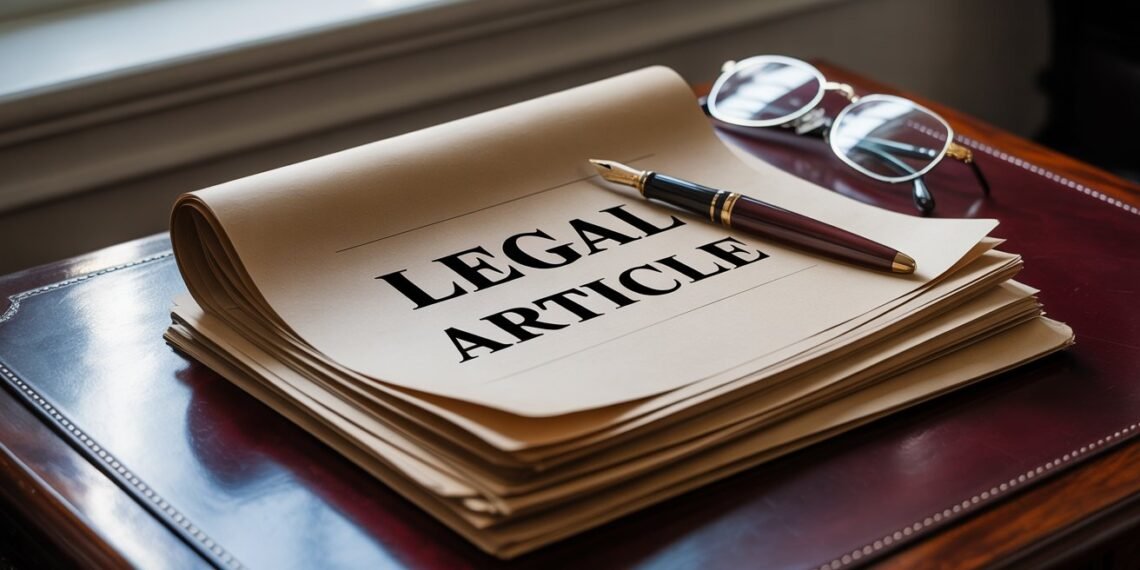Author: Chayanika Karmakar, Amity Law School, Amity University, Kolkata
Abstract:
This article explores the impact of media trials on the justice system in India. By shaping public opinion through newspapers, television, and digital platforms, media trials often pre-judge the guilt or innocence of the accused, creating risks for the fairness of judicial proceedings. Tracing developments from colonial press restrictions to the case K.M. Nanavati v. State of Maharashtra, the study shows how media influence has increasingly intersected with criminal justice. It examines constitutional protections under Article 19(1)(a) and the limits imposed by contempt laws, privacy rights, and the principle of a fair trial. Judicial responses in cases such as Sahara India v. SEBI and R. Rajagopal v. State of Tamil Nadu highlight the ongoing struggle to balance press freedom with judicial independence. The article concludes with the Comparative perspective with USA Supreme Court’s judgment and this article shows while a free press is vital to democracy, unchecked media trials threaten individual rights and judicial integrity, making statutory regulation and responsible journalism essential safeguards.
Introduction:
A media trial refers to the manner in which television, newspapers, and social media shape public opinion about an accused person by projecting an image of guilt or innocence even before a court delivers its judgement. Such portrayals often amount to parallel investigations by the media, which not only influence how society perceives an individual but may also undermine the impartiality of judicial proceedings. Media trials carry the risk of prejudicing the public mind, interfering with the administration of justice, and unfairly stigmatising individuals. At times, they can even fuel hatred and violence against those portrayed negatively, regardless of the eventual outcome in court.
Media trials often seen as shaping how the public perceives a person’s guilt or innocence, influencing reputation through coverage even before or after a court delivers its verdict.
The expression “Trial by Television” emerged after the broadcast of The Frost Programme on February 3, 1967.During this show, host David Frost fiercely questioned insurance fraudster Emil Savundra, and officials at ITV worried that such confrontational questioning might compromise Savundra’s right to a fair trial.
In India, the first attempt to control the press came in 1799, when Lord Wellesley introduced Press Regulations that restricted the growing newspaper industry. These restrictions were eased in 1813 under Lord Hastings. However, following the Revolt of 1857, the government banned the publication of seditious material and imposed strict penalties on violators in 1880, one of his earliest measures was to repeal this unpopular law.
As the Indian National Congress was formed, newspapers began to adopt a stronger, more critical voice, which led to frequent clashes with the colonial government. In response, the authorities brought in increasingly restrictive laws to curb press freedom. After World War II, as the transfer of power was being discussed, most of these restrictions were lifted. With independence and the adoption of the Constitution, press freedom saw major improvement, although it was severely curtailed during the Emergency of 1975.
The historical roots of media trials in India can be traced to the landmark case of K.M Nanavati v. State of Maharashtra. Commander Nanavati, a naval officer, was tried for the murder of Prem Bhagwan Ahuja, who was involved in an extramarital affair with Nanavati’s wife. What distinguished this case was not only the crime itself but also the unprecedented media coverage it received. This case became one of the earliest and most prominent examples of the media shaping public opinion in a criminal trial. The widespread coverage generated immense public sympathy for Nanavati, which significantly influenced the jury to return a verdict of acquittal, despite the presence of compelling evidence against him. The controversy that followed the Nanavati trial demonstrated the risks posed by media interference in judicial proceedings and contributed to the eventual abolition of the jury system in India. It continues to be regarded as a seminal instance of a media trial, illustrating the tension between press freedom and the fundamental rights to a fair trial.
Constitutional and Legal Dimension:
The freedom of the media in India is rooted in the broader right to freedom of speech and expression under Article 19(1)(a) of the Constitution. Its interaction with the judiciary is closely tied to the law of Contempt. Unlike the United States, the Indian Constitution does not provide a distinct guarantee for press freedom. Therefore, the freedom of speech and expression is neither more nor less for the media than the rights of the citizens of India. Several Sections of the Contempt of Courts Act, 1971 including Section 2 (defines civil and criminal contempt), Section 3 (protection for innocent publication), Section 4(allows fair and accurate reporting of judicial proceedings), Section 5 (safeguards fair criticism of judicial acts), Section 7 (protects the publication of proceedings held in chambers or in camera). Together, these provisions directly govern the delicate balance between judicial authority and media freedom.
“…A free press is not to be preferred to an independent judiciary, nor an independent judiciary to a free press. Neither has primacy over the other; both are indispensable to a free society….”
Freedom of the press or media in India is derived from the constitutional guarantee of freedom of speech and expression under Article 19(1)(a). It plays a vital role in fostering independent journalism and strengthening democracy by enabling citizens to express their views, whether in support of or against governmental actions.
The significance of Article 19 was underscored in Romesh Thappar v. State of Madras, where the Court recognised the media as an essential foundation of all democratic institutions. However, the case was dismissed on the grounds of ‘public safety’ and ‘public order’ as contemplated under Article 19(1)(a).
Freedom of the press and media is well established in India, though it remains subject to the reasonable restrictions set out under Article 19(2), which aim to safeguard public safety and national interest. At its core, Article 19 affirms that every individual possesses the right to freedom of opinion and expression. This includes the right to hold opinions without reference, as well as the right to seek, receive and disseminate information and ideas through any form of media, irrespective of frontiers.
In Sahara India Real Estate Corporation Ltd. v. SEBI, the Supreme Court emphasized that freedom of expression under the Constitution is not absolute and must sometimes give way to competing rights, particularly the right to a fair trial. The Court held that, in addition to the inherent powers under Section 151 of the Code of Civil Procedure, High Courts possess the authority to restrain media reporting when required to safeguard the administration of justice. Such judicial orders, aimed at protecting the fairness of proceedings, were held not to infringe Article 19(1)(a). Drawing upon Dharam Dutt v. Union of India, the Court further clarified that rights implied within Article 19(1)(c), though not expressly stated, are concomitant rights. Accordingly, a postponement of publication or restriction on publicity, where there exists a real and substantial risk of prejudice to the proper administration of justice or the fairness of a trial, would be constitutionally valid if it meets the standards of necessity and proportionality under Articles 14 and 19(2). In Saint Shri Asharam Bapu v. Union of India & Ors., the Court expressed its expectation that both print and electronic media would adhere to the guidelines laid down in earlier cases such as Manu Sharma, noting that the judiciary has often placed reliance on the media’s own sense of responsibility as an institution.
At the Bar Council of India meeting Hon’ble Mr. Justice Kurian Joseph of the Supreme Court of India highlighted the serious concerns arising from media trials in sub judice matters. Referring to the Nirbhaya rape case, he observed that excessive media coverage creates undue pressure on the judiciary and should therefore be avoided while proceedings are pending. He cautioned: “Please stop trying cases in the media till a case is over. Never try a case in the media; it creates a lot of pressure on judges; they are also human beings.“ Emphasising the intensity of public pressure during the Nirbhaya trial, Justice Joseph recalled a conversation with the presiding judge of the case, who remarked that “had I not given that punishment, they would have hung me”, since the media had already conveyed a predetermined outcome. Justice Kurian Joseph clarified, however, that the punishment was awarded on the basis of legal reasoning and not media influence.
“According to our law, a suspect/accused is entitled to a fair procedure and is presumed to be innocent till proved guilty in a court of law. None can be allowed to prejudge or prejudice his case by the time it goes to trial.”
The Court highlighted that although the freedom of the press under Article 19(1)(a) cannot be exercised in a manner that unjustly exposes personal ongoing investigations. Such actions not only risk compromising the fairness of judicial proceedings but also violate a person’s dignity, autonomy and reputation, all of which are integral aspects of the right to privacy.
In the case of R. Rajagopal v. State of Tamil Nadu, also known as the “Auto Shankar Case”, the Court held that the right to privacy includes the right to safeguard the privacy of one’s family, marriage, and other personal matters, unless publication is based on public records. The judgment drew a clear line between legitimate reporting in public interest and unwanted invasion of private life.
In the case of State of Maharashtra v. Rajendra Jawanmal Gandhi, the Court explicitly criticised media trials, observing that trials by press, electronic media or public agitation are antithetical to rule of law, as they tend to influence judges and prejudice fair trial rights.
Comparative Perspective
The American Supreme Court and the Circuit Courts, much like the High Courts in India, have shown mixed positions on the issue of media trials. At first, the Supreme Court leaned towards protecting the rights of the accused, but over time it began placing greater emphasis on press freedom. In the process, it introduced certain tests and remedies to deal with the harmful effects of pre-trial publicity, which could also serve as useful references in India.
In Rideau v. Louisiana, the Court developed the doctrine of “presumed prejudice”. The case involved a bank robbery, the kidnapping of three employees, and the murder of one of them. A video interview of the accused, Rideau, confessing to the crime in the presence of the Sheriff was broadcast on television for three consecutive days. His counsel argued that this publicity destroyed his right to a fair trial and requested a change of venue, which the trial court refused. The Supreme Court, however, held that the broadcast itself functioned as an unlawful “trial” before the public, carried out without legal counsel or judicial safeguards. It therefore presumed that the publicity had prejudiced the proceedings, setting an important precedent on the dangers of media influence before trial.
Conclusion:
The issue of media trials has far-reaching implications for the freedoms, rights, and duties of individuals, the judiciary and the press. To address this concern, specific legislation is necessary to regulate and streamline this problematic trend. One practical measure to curb inaccurate reporting of judicial decisions is the provision of daily orders and judgments to the public through online platforms. The Supreme Court has already initiated this process by making judgments and orders, including those of trial courts, available on the internet. This step reduces ambiguity in reporting and ensures greater transparency.
At the same time, the Legislature must also assume responsibility, since the current framework of self-regulation adopted by media regulatory bodies lacks binding legal authority. To create an effective statutory mechanism, a participatory approach is essential, where all stakeholders are consulted before framing laws. Such collaboration will ensure that the regulatory framework serves the interests of the nation, society, and individuals.
As the fourth estate of democracy, the media carries a solemn duty to present accurate information and uphold the principles enshrined in the Constitution. Journalists must recognise that their role extends beyond business interests, carrying with it a significant responsibility toward democratic values and public policy. The prevailing trend of commercialisation and sensationalism, particularly in matters that are sub judice, undermines these principles. It is therefore imperative that through effective legislation, proper enforcement, self-regulation, and a balanced understanding of the rights and responsibilities of the press, courts and citizens, this challenge can be meaningfully addressed in the near future.
Reference:
Judiciary and Media, available at: https://aphc.gov.in/docs/judiciary_media.pdf, (last visited on 19th August 2025).
Dr. S. Krishnan, ”Trial by Media: Concept and Phenomenon” 6 International Journal of Advanced Research 889-901 (2018).
Media Trial and Judiciary, available at: https://share.google/AVI4Aeen1vcwsBpQQ, (last visited on 19th August 2025)
The Contempt of Courts Act, 1971 (70 of 1971), ss. 2,3,4,5,7.
Freedom of Press in India, available at: https://www.drishtiias.com/blog/freedom-of-press-in-india, (last visited on 20th August 2025).



